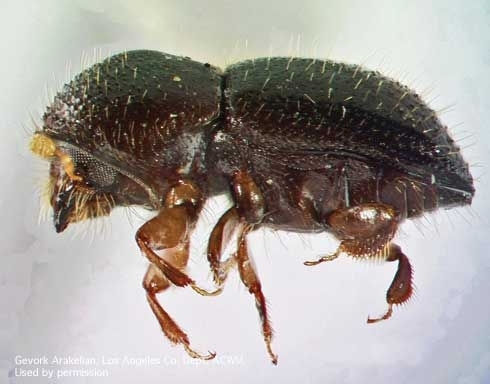![Male (left) and female walnut twig beetles. [L. Strand] Male (left) and female walnut twig beetles. [L. Strand]](http://ucanr.edu/blogs/UCIPMurbanpests/blogfiles/34720.jpg)
Walnut twig beetle and thousand cankers disease. Walnut twig beetle, Pityophthorus juglandis, is a tiny bark beetle that attacks only walnut trees. The beetle has been in California for many decades but recently became associated with a new fungus, Geosmithia morbida. The fungus kills the phloem and cambium of the tree but cannot move far within the tree on its own; it is dependent on the beetle to spread it as the beetle bores into trees to feed and reproduce. The disease caused by this beetle-fungus-complex is called thousand cankers disease because it leaves hundreds of lesions on severely infested trees. The disease can kill trees within several years and many black walnuts along roadsides and riparian areas throughout 
Polyphagous shot hole borer. Like the walnut twig beetle, this tiny borer, Euwallacea sp., spreads a fungal pathogen (in this case a Fusarium species) as it bores into trees. The relationship between the beetle and fungus is a symbiotic one with the beetle feeding on the fungus as it grows through the vascular system of trees. This beetle and pathogen have a broad host range and many trees have been affected including avocados, boxelder, coast live oak, liquidambar, and sycamore. Initial finds were in the Los Angeles area in 2012, but the beetle and disease have now been found as far north as Santa Cruz.
For more information on this pest, infestation zones, and ways you can help limit the spread, see the University of California Polyphagous Shot Hole Borer web site and the Center for Invasive Species Research.
[Text taken from the original article “Exotic Pests Invade California Landscapes” by Mary Louise Flint]
Keywords: